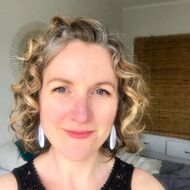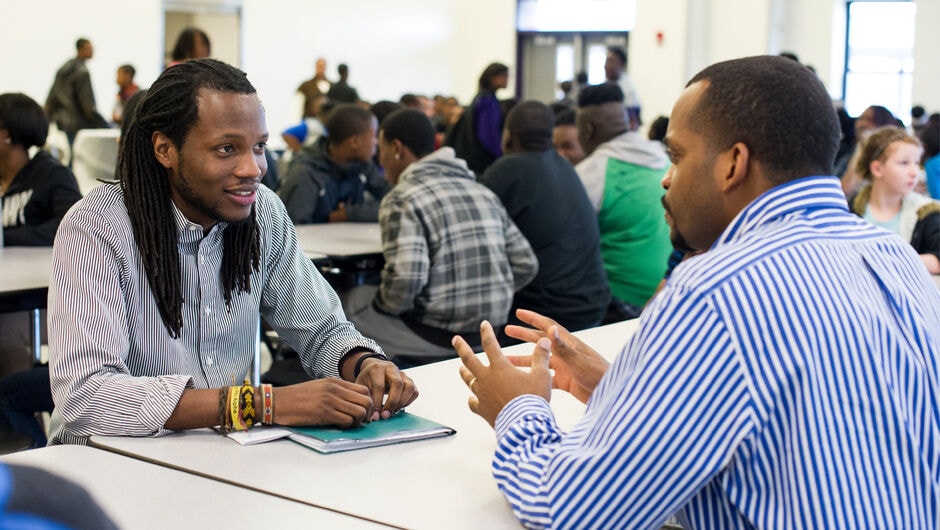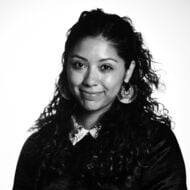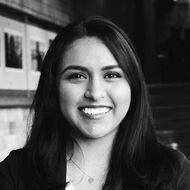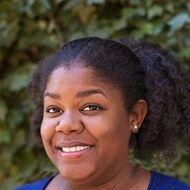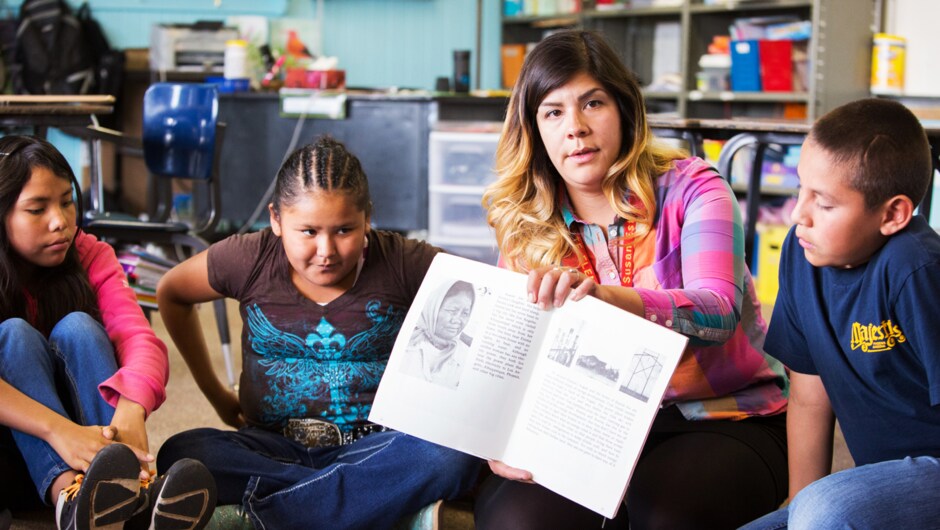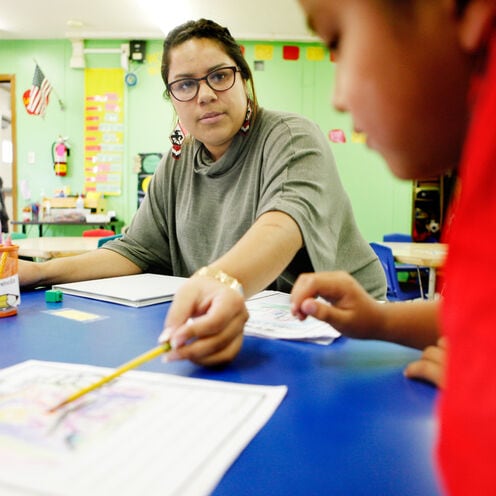
Building Indigenous Futures for Ourselves and Our Nations
Native educators share why representation matters in the classroom, and how they are rewriting the future for the next generation of Native students.
When Rennea Howell was completing her undergrad at UC Santa Cruz, she wasn’t thinking about going into education. Instead, she was imagining a future behind a microscope, doing research, maybe getting her Ph.D. But she remembers the moment when she felt a shift.
“It was probably one of the days where I was sitting in the lecture hall of 300 plus students. And I realized I was the only Native person in that room,” Howell says.
The real turning point was when Howell realized she was becoming the voice for all Native people, any time a Native perspective was discussed.
“I think that's an issue that many Native people face being in a space that is primarily non-Native. You become the voice, the representative, the opinion of all Indigenous peoples, which is a heavy burden.”
From that point forward, Howell began to look at her educational experience through a critical lens. Why was it that there were so few Native students on her college campus? She knew it wasn’t because they were any less brilliant and capable. But roadblocks, including access to an excellent education and support from educators and mentors who shared their identity, also meant that college wasn’t even an option for many Native students.
Less than 1 percent of our country’s teachers identify as American Indian, Alaska Native, and Native Hawaiian. This statistic reflects the painful legacy of the U.S. education system and its efforts throughout history to force Indigenous students to assimilate into Western ideals and erase Indigenous knowledge, perspectives, and lifeways.
Even today, far too many Native students feel invisible in the classroom without culturally affirming learning opportunities and supports. Yet research shows that teachers who share the background, culture, and language of their students have a profound impact on student outcomes. With the majority of Native students attending public schools away from tribal land, increasing the representation of Native educators across our education system is more important than ever.
These are some of the reasons why Howell chose a career path in education and became passionate about Native students in STEM. She is now a second-year corps member teaching high school chemistry and biology at McLaughlin High School, working with Lakota students on the Standing Rock Reservation in South Dakota. And though her background is quite different, having grown up in an urban area in Northern California, with family roots in the Quapaw Nation in Oklahoma, she brings an Indigenous perspective to the classroom that helps her students feel seen and heard.
In honor of Native Heritage Month, we’re sharing stories from Native educators about why representation in the classroom matters. They share the impact Native teachers have on breaking down barriers to opportunity for Native students, combatting the erasure of Indigenous perspectives in the classroom, and Indigenizing our education system to honor the knowledge and teachings that have always existed.
Representation in the Classroom
My Native teachers are my relatives
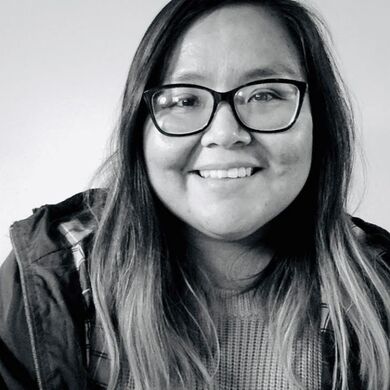
Juana Castillo (New Mexico ’17), Fifth Grade Teacher, Navajo Nation: I live in Pueblo Pintado, New Mexico. It's about 30 minutes from Chaco Canyon, so it's a pretty small rural community. I went to the BIE school here, preschool through eighth grade. Most of my teachers were either San Felipe Pueblo or teachers who were from the community, people I know who are from the same clan as me, or who my family knows. We are related in a certain way. They're all related somehow.
Lydia Yellow Hawk (South Dakota ‘19), Middle School Teacher, Sicangu Lakota: When I was in middle school, Sage Fast Dog was our Lakota language teacher and led our drum group. He is my uncle. I think of him in that sense too. The one thing that my Lakota teachers always did with students is they extended that relationship as a relative. So thinking about how I was raised, we always wanted to think of others, especially those who are Lakota as a relative. I always felt comfortable in their classroom because I viewed them as aunties and uncles. Extending that relationship automatically made me feel comfortable in who I am, where I was, and what I wanted to be.
Samantha Dale, Teacher Coach, Haliwa-Saponi: I was fortunate to go to an elementary school that was within my tribal community. The majority of the staff were local Indigenous people from the community. So I was very familiar with them. I would see them at church. I would see them at tribal functions, so they were family. We always ask, “Who's your people?” to try to figure out how we were connected. We had to go to middle school and high school outside of our small town of Hollister, North Carolina. I didn't have as many Indigenous teachers there. They were sparse within the school system.
A lack of Indigenous perspectives in school left room for harmful stereotypes to flourish
Rennea Howell (South Dakota ’19), High School Teacher, Quapaw Nation: Representation really does matter because it is the unique perspective of people who are different who honor those differences of their students. I definitely think that representation is important and it could have allowed me to come into my identity a lot sooner.
I'm from Northern California, from a pretty conservative region within the state. We didn’t discuss identity in a lot of contexts, especially within the K-12 system. I think that unwillingness to seek out new perspectives led to the perpetuation of harmful stereotypes about Native people. I don't think that it was an intentional malicious act. It was just falling into the status quo that upheld like white supremacist views of Indigenous people.
Joshua Reid (Washington ‘94), Associate Professor, Director, Center for the Study of the Pacific Northwest, Snohomish Indian Nation: Most of the history, if not all of the history that I learned in K-12, was rooted in a very old-school, traditional assumption of North America as a wilderness, that this was an empty land with only a scattering of Native peoples around... and that was about it. This is not an uncommon experience even for college students whom I work with today.
Most of my history came to me through family stories from my grandfather or my mom's activism with different urban Native organizations and civil rights organizations like the Black Panthers. This was a whole different kind of curriculum that I got at home.
Samantha Dale: The only time we were taught anything about Indigenous people in middle and high school was through the lens of Thanksgiving and Columbus. And we often heard about Indigenous people being savages through the lost colony story. And so those were the two references that teachers used to talk about Indigenous people, and it was always in the past tense. It was never shared with other students that we still existed. So learning about Indigenous people and your own culture, and connecting with your history, your story, it didn't happen in the classroom. It had to happen at home.
I became an educator to help students interrogate our history
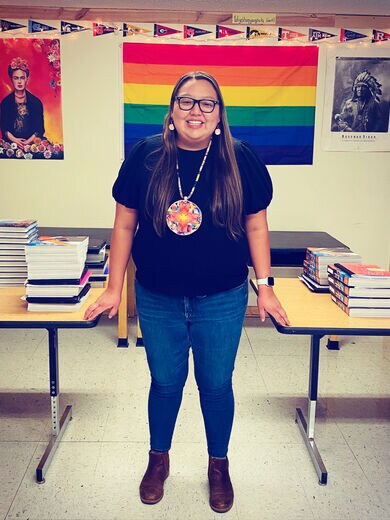
Lydia Yellow Hawk: While I was teaching the school's social studies curriculum my students also did a novel study of An Indigenous Peoples’ History of the United States and read this history from a more critical Indigenous lens. I had them think critically about the curriculum that was given to us by our school district so they could understand and make meaning of our own history in their own way. I feel like our students are often force-fed these histories and not really taught to question it.
Joshua Reid: My experience laid a good foundation for a lot of my middle school students to better understand Native nations today and to also think critically about our history. Fortunately, I worked with principals who were also really supportive of me crafting my own curriculum. That gave me an opportunity to include some very healthy doses of Native history with my students, including a real in-depth unit on treaties. They really got a lot out of it. And that's the same type of approach that I take to my classrooms today at the college level.
Rennea Howell: Not enough representation and then a disregard of Native understanding of the world and the intimate knowledge we have of the land that our ancestors are from is what drove me into education. I feel like it wasn't incidental. It was very purposeful that I chose to go into education as a way to combat the issues that I was seeing.
As a teacher, now I bring my relatives into the classroom
Juana Casillo: When I was teaching Navajo students in Crownpoint, I felt like I could relate to my students more in a way. And my students could relate to me too. I look like their aunt or their mom. It was much easier to speak about the Diné way of life, our values, the reason why we're here, and why education is important. I was able to speak to them and reach out to them and to be on that level with them.
Lydia Yellow Hawk: In social studies, we talk a lot about government on a state and federal level. But I also wanted to take it to a tribal level and talk about our traditional Lakota laws and so I have used the Oceti Sakowin Essential Understandings to help frame these lessons. I've had access to these teachings from my family, but I don't want my students to just hear it from me. My grandma is someone who I have really relied on for this information. And so I will occasionally bring her in to talk to the students. Our community members also have a voice and a say in how our students learn as well
I don’t want the next generation to feel invisible
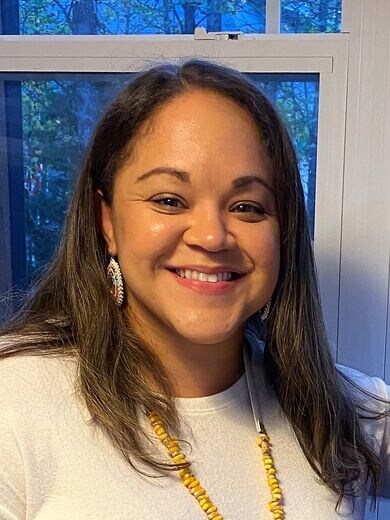
Samantha Dale: When I taught at a tribal school, the majority of my students were members of the same tribe I was from. I think it's important that students saw me as someone who left our home community and then came back and was truly invested in the improvement of their education.
I always felt like it was important for students to see someone who looks like them because representation just matters, period. It is part of my legacy to make sure that the next generation doesn't feel invisible. They feel heard, they feel seen, and they feel valued and that begins with my own two sons. I want them to be proud of who they are, where they come from, and never let anyone make you feel invisible.
Leading a Movement to Indigenize Education
A path toward decolonizing our education systems means critically examining our history.
Lydia Yellow Hawk: In college, once I started seeing myself within these histories and I started understanding and thinking about it critically, I started to see the systems that have impacted the way we live. And once I started to see myself within these systems as an Indigenous person, as a woman, as a person whose family is going through these traumas, I was able to think about how to find solutions and how to help others. I think if students can think about these systems and these environments in that way, they can ultimately be change-makers. I hope to someday have students realize that vision. But I think we need more people to get that understanding.
Joshua Reid: I think one of the critical narrative pieces that people should understand is the twin sins of this country. Most people have moved pretty far along at understanding that one of those sins is slavery. But very few really understand the other sin, that this country is built on the theft of Indigenous homelands. And that can make a lot of people uncomfortable. Just gaining some understanding of this nation's past with slavery has already made a lot of people uncomfortable.
Connecting that to social justice and structural racism today is absolutely critical. You can't get to understanding these tensions today until you excavate that past to understand that American freedom is specifically built on the unfreedom of others and the theft of Indigenous homelands and resources. And it's not to talk about how evil the country is, but it's to understand that reality so that we can move beyond and figure out, well, what do we do about that? I think understanding the past is a first step in the right direction, but it's not the only step.
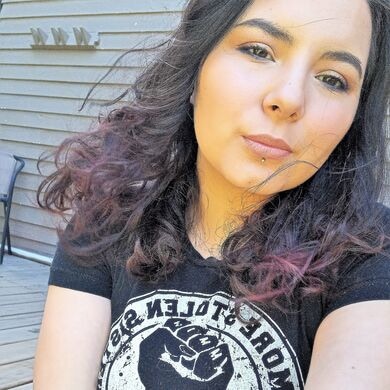
Rennea Howell: If you can find Native communities in the region, ask them what their history is, learn from a primary source, because not only are you uplifting the narrative of those people, you are also letting them know that there is somebody in that community that cares about what's happened to them and is willing to do the work to honor that. For many non-Native folks, these conversations might be awkward or uncomfortable to learn at first. And that’s okay. Or if it makes you feel white guilt, that's okay too. What's not okay is being complacent. What's not okay is teaching the same history that is going to perpetuate Native erasure and to invalidate the identity of students who could be sitting three feet in front of you.
Our stories are everywhere, not just in history books.
Samantha Dale: What I wish people knew when it came to Indigenous education is that we are still here. We matter, we want to be seen and heard, and valued. Let Indigenous people write the history. Learn about the people whose land your school is on. Become aware of where you are and who had to sacrifice for you to have that space because Indigenous people lost a lot for us to even exist on this land. Have the Indigenous communities around you be an active part of the education that you're providing, not just in November and not just on Columbus Day, but every day.
Lydia Yellow Hawk: When I think about indigenizing education, some people want to think about it in a pre-colonial context. Even though we do have that history we also have to think about where we are in our own history as well. Everything that we're experiencing as Indigenous peoples today is also a part of that history. And we need to think about our issues and our culture, our language, in a contemporary sense because we're not a people of the past. Yes, we honor our ancestors, we honor what did happen to us. But we also have to focus on the present and the future for the continued survival of our relatives.
Supporting the Next Generation of Leaders & Activists
With more Native educators, we are able to break down barriers to opportunity.
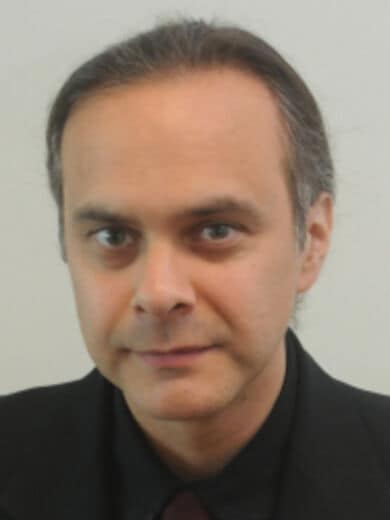
Joshua Reid: I think it would encourage more Native students to complete high school, to go on to college and to see graduate school, master's degrees, and Ph.Ds as real possibilities. The population demographics for Native students are still among the worst with all of those metrics. And so the more of us who are in these types of positions where we can help to support Native students to make sure that they complete their college degree, I think that that can be a game-changer in the long run.
I'm already seeing the ways that history itself as a discipline, especially U.S. history, history of the North American West, or even environmental history is changing because we have Native scholars doing the research and writing the scholarship. That has radically changed the discipline in those fields to be more inclusive, to tell more authentic stories, to write histories of the past in collaboration with Native nations, and working on projects that make sense to Indigenous peoples and are of value to them.
Rennea Howell: I do believe my students are capable of anything. Whether or not they are given the opportunity to achieve those things is a different story. And I think it does tie into whether or not we are Indigenizing our curriculum, whether or not we have Indigenous representation, whether or not we're giving students those role models that they can strive to be like. I feel that in a lot of senses, the validity of having representation is often kind of looked at with a side-eye. It's not prioritized in the way that I think it should be.
Juana Castillo: For students growing up today, we want it to be the norm for them to see Indigenous people from their community in the classroom just like how I was growing up. I'm hoping that it becomes the norm and you see more Indigenous educators in the classroom motivating more of our students to achieve more.
Samantha Dale: I think what would be possible is that we are no longer invisible and we are fully represented in all spaces. If I look forward to my grandchildren in classrooms. I would want them to have a teacher who is bold and courageous and talks about all people and tells their true story.
What I'm doing now is not only for this generation but for the rest of the generations to come. The work that I do at home, the education that we provide my sons about who they are and where they come from matters so much because I want them to walk into any space and proudly say, I am an Indigenous man. I am from the Haliwa-Saponi tribe. I am a proud North Carolinian. I am from a small community and I am here advocating for myself.
We want to hear your opinions! To submit an idea for an Opinion piece or offer feedback on this story, visit our Suggestion Box.
Sign up to receive articles like this in your inbox!
Thanks for signing up!
Content is loading...


